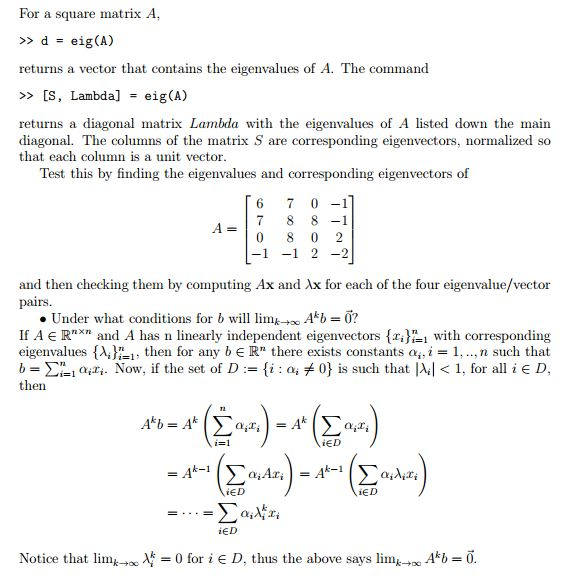

It results in the eigenvalues in the form which is specified as eigvalOption.ġ. This algorithm works for non-symmetry matrices as well.
GET EIGENVALUES MATLAB FULL
It results in full matrix M F whose columns are the corresponding left eigenvectors so that M F‘*P = D*M F‘*Q. It results in diagonal matrix M D of generalized eigenvalues and full matrix V whose columns are the corresponding right eigenvectors, so that M*V = Q*V* M D. It results in a column vector that contains the generalized eigenvalues of square matrices P and Q. It results in full matrix M Fwhose columns are the corresponding left eigenvectors, so that M F‘*M = M D* M F‘. It results ina diagonal matrix M D of eigenvalues and matrix V whose columns are the corresponding right eigenvectors, so that M*V = V*M. It results in a column vector consisting of the eigenvalues with respect to the square matrix M. Syntaxīelow awe will understand the syntax with description: Syntax The values of v corresponding to that satisfy the equation are counted as the right eigenvectors. The values corresponding to λ that satisfy the equation specified in the above form, are counted as eigenvalues. Where M is an n-by-n input matrix, ‘v’ is a column vector having a length of size ‘n’, and λ is a scalar factor. See eigsvdgui in Numerical Computing with MATLAB or Cleve's Laboratory.Hadoop, Data Science, Statistics & others The resulting diagonal contains the singular values. Now a two-sided QR iteration reduces the off diagonal to negligible size. Use a Householder operating from the left to zero a column and then another Householder operating from the right to zero most of a row. Make our test matrix rectangular by inserting a couple of rows of the identity matrix. The limit is the diagonal containing the eigenvalues. Now the QR iteration works on just two vectors, the diagonal and the off-diagonal. (The computation is done on half of the matrix, but we show the entire array.)īy symmetry the six Householders that zero the columns also zero the rows. The eigenvalues of a bump are a complex conjugate pair of eigenvalues of the input matrix. This example has one bump in rows 3 and 4. So the final matrix may have 2-by-2 bumps on the diagonal. The remaining subdiagonals require just one or two iterations each.Īll this is done with real arithmetic, although a real, nonsymmetric matrix may have complex eigenvalues. The next two rows require three iterations each. The element below the diagonal in the last row is the initial target it requires four iterations. The iteration count is shown in the title. The corresponding diagonal element is an eigenvalue. Now the QR algorithm gradually reduces most subdiagonal elements to roundoff level, so they can be set to zero.



The result is known as a Hessenberg matrix (don't let spell-checkers change that to Heisenberg matrix.) The initial reduction uses n-2 Householder similarites to introduce zeroes below the subdiagonal a column at a time. Here is a static picture of the starting matrix. The starting matrix for all three variants is based on flipping the Rosser matrix.


 0 kommentar(er)
0 kommentar(er)
